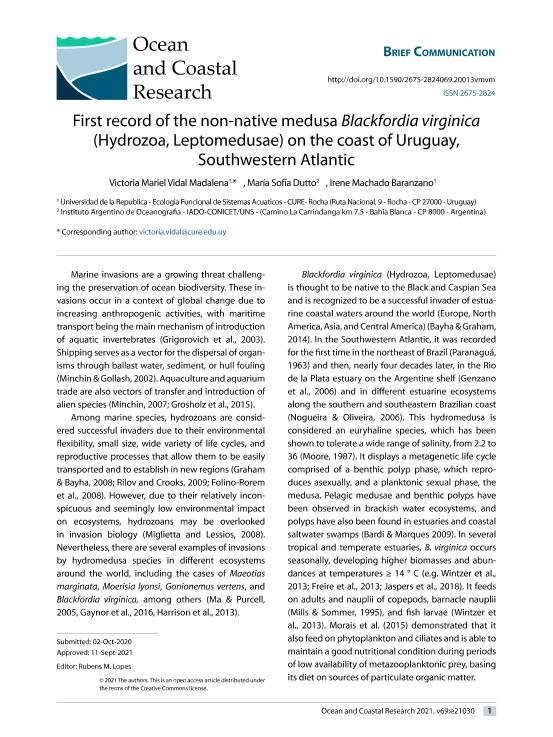Mostrar el registro sencillo del ítem
dc.contributor.author
Vidal Madalena, Victoria Mariel
dc.contributor.author
Dutto, María Sofía

dc.contributor.author
Machado Baranzano, Irene
dc.date.available
2022-05-17T13:31:20Z
dc.date.issued
2021-12-19
dc.identifier.citation
Vidal Madalena, Victoria Mariel; Dutto, María Sofía; Machado Baranzano, Irene; First record of the non-native medusa Blackfordia virginica (Hydrozoa, Leptomedusae) on the coast of Uruguay, Southwestern Atlantic; Universidade de São Paulo; Ocean and Coastal Research; 69; 19-12-2021; 1-8
dc.identifier.issn
2675-2824
dc.identifier.uri
http://hdl.handle.net/11336/157739
dc.description.abstract
Marine invasions are a growing threat challenging the preservation of ocean biodiversity. These invasions occur in a context of global change due to increasing anthropogenic activities, with maritime transport being the main mechanism of introduction of aquatic invertebrates (Grigorovich et al., 2003). Shipping serves as a vector for the dispersal of organisms through ballast water, sediment, or hull fouling (Minchin & Gollash, 2002). Aquaculture and aquarium trade are also vectors of transfer and introduction of alien species (Minchin, 2007; Grosholz et al., 2015). Among marine species, hydrozoans are considered successful invaders due to their environmental flexibility, small size, wide variety of life cycles, and reproductive processes that allow them to be easily transported and to establish in new regions (Graham & Bayha, 2008; Rilov and Crooks, 2009; Folino-Rorem et al., 2008). However, due to their relatively inconspicuous and seemingly low environmental impact on ecosystems, hydrozoans may be overlooked in invasion biology (Miglietta and Lessios, 2008). Nevertheless, there are several examples of invasions by hydromedusa species in different ecosystems around the world, including the cases of Maeotias marginata, Moerisia lyonsi, Gonionemus vertens, and Blackfordia virginica, among others (Ma & Purcell, 2005, Gaynor et al., 2016, Harrison et al., 2013).
dc.format
application/pdf
dc.language.iso
eng
dc.publisher
Universidade de São Paulo

dc.rights
info:eu-repo/semantics/openAccess
dc.rights.uri
https://creativecommons.org/licenses/by/2.5/ar/
dc.subject
HYDROMEDUSAE
dc.subject
INVASIVE SPECIES
dc.subject
COASTAL ECOSYSTEM
dc.subject
URUGUAY
dc.subject.classification
Ecología

dc.subject.classification
Ciencias Biológicas

dc.subject.classification
CIENCIAS NATURALES Y EXACTAS

dc.title
First record of the non-native medusa Blackfordia virginica (Hydrozoa, Leptomedusae) on the coast of Uruguay, Southwestern Atlantic
dc.type
info:eu-repo/semantics/article
dc.type
info:ar-repo/semantics/artículo
dc.type
info:eu-repo/semantics/publishedVersion
dc.date.updated
2022-04-26T18:47:16Z
dc.journal.volume
69
dc.journal.pagination
1-8
dc.journal.pais
Brasil

dc.description.fil
Fil: Vidal Madalena, Victoria Mariel. Universidad de la Republica; Uruguay
dc.description.fil
Fil: Dutto, María Sofía. Consejo Nacional de Investigaciones Científicas y Técnicas. Centro Científico Tecnológico Conicet - Bahía Blanca. Instituto Argentino de Oceanografía. Universidad Nacional del Sur. Instituto Argentino de Oceanografía; Argentina
dc.description.fil
Fil: Machado Baranzano, Irene. Universidad de la República; Uruguay
dc.journal.title
Ocean and Coastal Research
dc.relation.alternativeid
info:eu-repo/semantics/altIdentifier/doi/http://dx.doi.org/10.1590/2675-2824069.20013vmvm
dc.relation.alternativeid
info:eu-repo/semantics/altIdentifier/url/https://www.ocr-journal.org/index.php/view-articles
Archivos asociados
